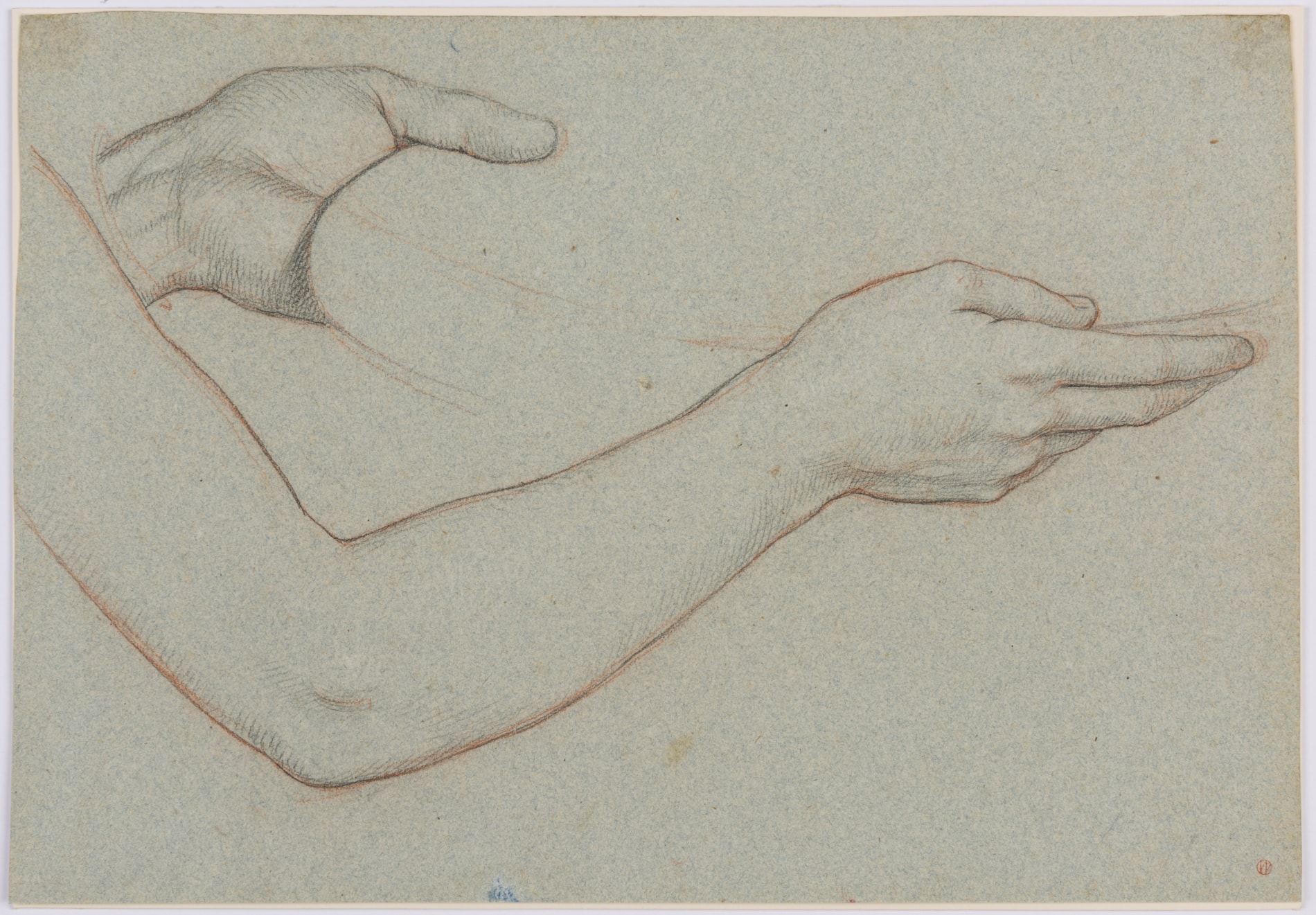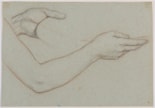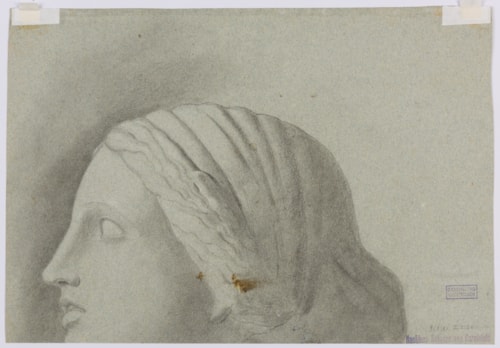Ludwig Ferdinand SCHNORR VON CAROLSFELD
(Königsberg 1788 - Vienna 1853)
Study of an Arm and Hands Holding a Dish
Sold
Black and red chalk on pale blue paper.
A partial study of the head of a woman after an antique drawn in black chalk on the verso.
213 x 310 mm. (8 3/8 x 12 1/4 in.)
A partial study of the head of a woman after an antique drawn in black chalk on the verso.
213 x 310 mm. (8 3/8 x 12 1/4 in.)
This drawing is a preliminary study for the arm and hands of the young boy bringing a plate of fish to Jesus, at the centre of the monumental mural of The Feeding of the Five Thousand painted by Ludwig Schnorr von Carolsfeld in 1839 for the refectory of the Armenian Catholic Mekhitarist Monastery in Vienna. Painted on canvas and, at six metres in width, spanning the entire end wall of the refectory, the painting is one of the most significant Nazarene works of the 19th century in Austria.
On the 8th of August, 1839, Ludwig wrote to his brother Julius: ‘Yesterday I completed my large painting The Feeding of the Five Thousand, which I worked on for almost a year, especially recently with great effort. The picture is about 20 feet long and over 15 feet high. Although it is an oil painting, I made it right in the designated place in the refectory of the spiritual Congregation of the Armenian Mekhitharists. Although I was only paid very little for the work, I was very pleased to be able to do something of this scale again, for it is probably the only work in Vienna of such size.’ In November 1839, the Emperor Ferdinand I and his wife, Maria Anna of Savoy, together with the Empress Mother and Archduchess Sophie, visited the monastery to see the new painting.
A large compositional study for the painting of The Feeding of the Five Thousand was sold in the Ludwig Schnorr von Carolsfeld estate sale in Vienna in 1911. A stylistically similar sheet of four studies of hands, drawn in black, red and white chalk on blue paper, was formerly in the collection of Julius Held and was sold at auction in New York in 2009.
The present sheet bears the collector’s mark of the German art historian Franz Winzinger (1910-1983).
On the 8th of August, 1839, Ludwig wrote to his brother Julius: ‘Yesterday I completed my large painting The Feeding of the Five Thousand, which I worked on for almost a year, especially recently with great effort. The picture is about 20 feet long and over 15 feet high. Although it is an oil painting, I made it right in the designated place in the refectory of the spiritual Congregation of the Armenian Mekhitharists. Although I was only paid very little for the work, I was very pleased to be able to do something of this scale again, for it is probably the only work in Vienna of such size.’ In November 1839, the Emperor Ferdinand I and his wife, Maria Anna of Savoy, together with the Empress Mother and Archduchess Sophie, visited the monastery to see the new painting.
A large compositional study for the painting of The Feeding of the Five Thousand was sold in the Ludwig Schnorr von Carolsfeld estate sale in Vienna in 1911. A stylistically similar sheet of four studies of hands, drawn in black, red and white chalk on blue paper, was formerly in the collection of Julius Held and was sold at auction in New York in 2009.
The present sheet bears the collector’s mark of the German art historian Franz Winzinger (1910-1983).
The German Romantic painter and printmaker Ludwig Ferdinand Schnorr von Carolsfeld was born into to an accomplished family of artists. His father and first teacher, Veit Hans Friedrich Schnorr von Carolsfeld, was a professor and director of the Academy in Leipzig, while his younger brother was the Nazarene painter Julius Schnorr von Carolsfeld. At the age of sixteen, Ludwig moved to Vienna and began his studies at the Akademie der bildenden Künste under Friedrich Heinrich Füger. It was at the Vienna Academy that Schnorr became associated with his fellow student Johann Friedrich Overbeck, who was searching for a style beyond the institution’s strict classicism. Overbeck became a founder of the Nazarene movement, and was eventually expelled from the Academy. Schnorr, however, remained enrolled in the Academy and worked in Vienna for the rest of his career, unlike his brother Julius, who followed Overbeck to Rome in 1815. Ludwig’s first and most influential patron was Duke Albert of Saxe-Teschen, one of the greatest collectors of prints and drawings and the founder of the Albertina Museum. He also earned the support of Archduke Johann of Austria, for whose country home of Brandhof he painted several works. In 1821 Schnorr converted to Roman Catholicism, under the influence of the poet Friedrich Schlegel, and at the same time took on the young Moritz von Schwind as a pupil. The patronage of the Archduke Johann ultimately led to Schnorr’s acceptance into the Vienna Akademie in 1835, as well as his appointment in 1843 as the curator of the Imperial Gallery of the Belvedere Palace in Vienna, which today holds a large collection of the artist’s works.
Provenance
The estate of the artist, with the Nachlass Schnorr von Carolsfeld stamp (not in Lugt) on the verso
The Schnorr von Carolsfeld estate sale, Vienna, Dorotheum, 18 May 1911, probably as part of lots 113-122 (various studies of draperies, arms and hands, all in red and black chalk)
Franz Winzinger, Oettingen (Lugt 2600a and with the Sammlung Winzinger collection stamp [not in Lugt] on the verso).
The Schnorr von Carolsfeld estate sale, Vienna, Dorotheum, 18 May 1911, probably as part of lots 113-122 (various studies of draperies, arms and hands, all in red and black chalk)
Franz Winzinger, Oettingen (Lugt 2600a and with the Sammlung Winzinger collection stamp [not in Lugt] on the verso).





